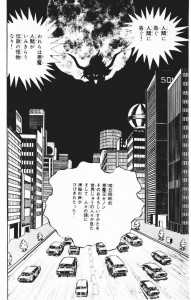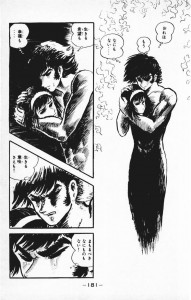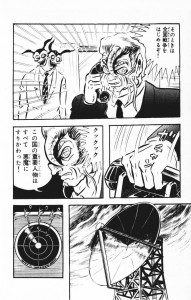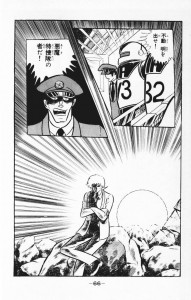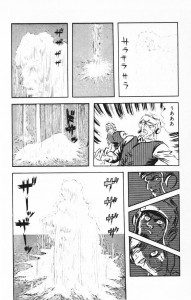Devilman (part 2)
Index
Part I: Introduction; History, plot and a general review (no spoilers)
Part II: Comment and Interpretation (spoilers)
Part III: Other appearances in mangas and videogames (updated on 6 August 2012)
COMMENT AND INTERPRETATION
As we have said before, Devilman has a very strong psychological side
inside it. We can read the Devilman as the man that has integrated in
himself his Shadow, the denied part of the unconscious mind. A Devilman
accepts the dark sides of both his personality and reality and he
accepts the struggle to integrate them into his conscious mind: thus the
darkness is no longer a menace to him but it becomes a source of inner
strenght, which reflects itself in the outer reality too.
We can read thus the demons as the raw forces of the unconscious mind,
which has been greatly denied by the modern man and the modern society
as a whole, because of their menacing and destabilishing, caothic,
power, a power which is also the very source of life (and
consciousness). It has been denied and thus it erupts suddendly in
destructive forms. One of the scenes that explains this better is when
Akuma Oh Xenon (Demon King Xenon) suddendly bursts out from the shadows
and speaks a message of doom for the humanity before the first assault
of the demons.
“We are the demons! The legendary creatures which you humans despise!”
Xenon says, remarking that demons now will claim the earth once more,
starting a war with humanity.
However, the strongest weapon of the demons doesn’t reside in their
monstrous bodies and in their superhuman strenght, but in the very deep
recesses of the human mind. In fact, humanity drowns in a crescendo of
paranoia: science and rationality are powerless in front of the eruption
of the collective neurosis; at the contrary, science actually helps in
accelerating the collective hysteria, both by giving deadly weapons to
the special forces and by justifing the persecutions and the conflicts
among the humans.
Paradoxically, humankind turns into mindless demons because of their
fear of the demons; the only true humans left are the Devilmen, people
who have accepted and integrated the “demonic” side of life into their
very own hearts. Also, the first ones to fall victims of demonic
possession are Earth’s leaders! There is a very dramatic representation
of the Cold War conflict, since the president of Russian Federation is
being possessed by the demons and threathens to launch a battery of
nukes on all the world during the first wave of the attack of the
demons.
Miki’s tragic death (lynched by a mob because considered a “witch”) can
symbolize both the death of Hope (like Nagai himself stated) and the
death of the Junghian Anima, thus the inconscious, feminine part of the
male’s psyche, an irrational, sentimental, part deeply connected to the
unconscious mind and with the very root of life itself. With the death
of Miki, humankind is definitevely doomed, the thin connection with life
(which conciliated the opposites: light and darkness, conscious and
unconscious, demons and humans) has definitevely been severed.
We thus return once more to Nietzsche’s paradox: “He who fights with
monsters should be careful lest he thereby become a monster. And if thou
gaze long into an abyss, the abyss will also gaze into thee.”. Humanity
fails to successfully win it’s demons because it denies them
altogether; the Devilmen fail to save humanity from extinction because
their effort goes un-noticed and they are catalogued as “monsters” by
the humans who have not integrated their denied side into them; the
demons lose too because they all die with the exception of Lucifer, who
realizes too late how hollow has been his very own effort. Lucifer, in
fact, has done the same error of the humans. He originally fought God to
defend the weak demon race against the fury of God, who wanted to
exterminate them all. Lucifer won and God left, at least for the moment.
Demons decided to cast themselves into ice for a long sleep, but when
they woke up they found humankind. Demons did the same error of God:
they wanted to exterminate the humans only because they didn’t like them
and because they were weaker than them. Thus Lucifer, who fought God,
made the same mistake of God: once again, what has been considered the
“enemy”, the “bad”, the “evil”, resurfaces once more in the shadows and
the demon’s hunter becomes a demon himself.
However, Lucifer is portrayed as sitting near the water, near a shining
light. Water is a symbol for life, so we can guess that life will once
more form itself and maybe, this time, the world won’t face a so
dramatic struggle…we don’t know.
Devilman uses also some very interesting and subtle biblical
references. The best of them is surely the figure of Lucifer: Lucifer is
Ryo, Akira best friend. He discovers his true identity after
discovering that his identity as Ryo is a lie and after the shattering
of his very human mind. In fact, Lucifer incarnated in an human to
discover the weaknesses of the human’s heart.
Also, Devilman uses in a very clever way the original concept of
Lucifer: Lucifer as the Morning Star, the star that shines before the
full rise of the Sun. This star could be tought as the Sun (God) but it
isn’t. It’s a deceive. This concept is subtle used when Akira discovers
Ryo’s true identity. Ryo and Akira’s meeting occurs when the sun is
rising and when Ryo/Lucifer leaves the scene, the sun has fully risen.
After that, Akira realizes that Ryo is indeed Lucifer. It’s a very
subtle, coherent and clever use of this biblical concept.
Another biblical reference can be seen after Russia is swallowed by a
blinding sphere of light: an aircraft squad is sent to investigate, but
they all dissolve in the blinding light with the exception of one. When
he returns to the base, he gets out of his plane just to dissolve into a
pillar of salt, just like Lot’s wife in the Old Testament.
Lot’s wife tale can be summarized as this: when God destroyed Sodom and
Gomorrah, Lot and his family were told to flee without looking back;
Lot’s wife was disobedient and was immediately changed into a pillar of
salt.
We can the guess that the blinding sphere of light is some kind of
device of God (in fact, when Ryo sees it on the television, it scares
him, so this is another clue in this direction). The sphere leaves Earth
after Miki’s death and before the final battle between the Devilmen and
the demons, meaning that the outline of the final battle can be only
critical and dramatic, leaving only losers without a real winner. The
true nature of the sphere is never explained in the comic, so we can
only guess. Maybe it’s related to the Self, to the totality of conscious
and unconscious mind and thus harmony. The sphere leaving Earth thus
would mean that harmony is definitevely corrupted.
This can be consistent since the humanity was saved once by nuclear
holocaust (the possessed president of the Russian Federation launched a
battery of nukes towards America and the rest of the world) by the
sphere’s intervention, which also dissolved Russia from the face of the
Earth.
As you can see, Devilman’s world is multi-layered, complex and with
numerous symbolic references. Maybe the concepts that connects it all is
the struggle between opposities, a lesson derived from the religious
and philosophical traditions as Zen, Buddhism, Taoism or Christianity
that is also is a very big psychological truth: the opposities must be
conciliated, they must dialogue to each other in order to find a dynamic
equilibrium that must be kept day by day. Chaos needs order to not
collapse on itself; order needs Chaos to avoid the stagnation; like
Nagarjuna stated, all things are empty in themselves and are true only
in a dynamic relationship with each other.
The Devilman’s saga doesn’t end with Devilman tough: there are
numerous spin-offs, appaerances and a full fledged sequel (the
monumental Devilman Lady, spanning on 17 voumes). More of this in the
next section of the article.

